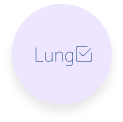A DEEP BREATH CAN
GIVE YOU THE COURAGE
TO ACT.
When it comes to lung cancer, early detection is key.
THE EARLIER LUNG CANCER IS FOUND, THE BETTER YOUR CHANCES ARE
A 2020 report showed improved survival rates* when lung cancer was caught early:

Over 70% of people will survive for at least 3 years after their lung cancer is diagnosed at Stage 1.

5% of people will survive for at least 3 years after their lung cancer is diagnosed at Stage 4.
Only ~21% of lung cancers are found at Stage 1, while about 50% are not discovered until Stage 4.
Acting early can make all the difference.
SCREENING CAN HELP DETECT LUNG CANCER AT AN EARLIER STAGE.
Lung cancer screening is for people who may be at risk of getting cancer, but who generally feel fine and don’t have any symptoms. If you or a loved one are eligible, your healthcare professional may recommend screening with a low-dose computed tomography (LDCT) scan. This scan takes a detailed picture of your chest to check for signs of lung cancer, and can help find some lung cancers early, when treatment has a better chance of working.
Currently, LDCT screening is available in the following provinces:
Visit the site for your province to find out if you’re eligible.
Early detection using LDCT scanning has been shown
to reduce lung cancer deaths by 20%


Take our assessment to help you start your early detection journey, then talk to your healthcare professional.
UNDERSTANDING THE EARLY DETECTION JOURNEY
Everyone’s health journey is different, but it’s important to recognize your symptoms early and actively work with your healthcare team to investigate any concerning issues you’re noticing with your lungs.

Prevention
Not smoking, or quitting smoking.
Smoking tobacco is the leading cause of lung cancer.
It’s never too late to quit! Quitting smoking at any age can help reduce the risk of developing lung cancer.

Symptoms
Noticing a change in your body.
Pay close attention to your lungs and body, and acknowledge when something unusual is going on.
Listen to your loved ones. They may notice changes that you don’t.

Seeking help
Realizing that you need to talk to your healthcare professional (HCP) about your symptoms.
People who see their HCPs regularly are more likely to report symptoms, be referred for imaging, and receive diagnostic testing.
Your HCP has a holistic, long-term view of your health.

Seeing your HCP
Meeting with your healthcare professional (HCP) to discuss your symptoms and concerns.
Self-advocacy and persistence can help lead to testing and referrals.
Trust your intuition – you know your body best!

Lung cancer screening
Undergoing LDCT.
Be sure to discuss the options along with the pros and cons with your healthcare professional.
Remember that the lung cancer screening process varies by province.

Next steps
Proceed to the next step based on the results of your lung cancer screening.
Lung screening is best for those who are at high-risk for lung cancer and who are not experiencing any symptoms. Depending on your age and smoking history, you may be immediately eligible. Talk to your healthcare professional about your eligibility for screening.
BE YOUR OWN ADVOCATE FOR YOUR LUNG HEALTH.
SDM is an important part of the lung cancer screening process.
When considering whether to undergo lung cancer screening, you and your healthcare team should engage in shared decision-making (SDM) to figure out if it’s the right choice for you.
SDM involves having an active and engaged discussion with your healthcare professional about things like:
Your options
You may choose to undergo screening, or not.
The ‘pros’ and ‘cons’ of screening
Why you may, or may not, want to undergo screening.
Your preferences
Your thoughts and feelings on undergoing screening.
Shared decision-making can help improve your lung cancer screening process.
A recent study found that people who engaged in a high-quality SDM process with their healthcare professional before undergoing lung cancer screening were:†
More knowledgeable about lung cancer screening
More comfortable with their choice to undergo lung cancer screening
More likely to agree to be screened again for lung cancer
If you have questions or concerns about lung cancer screening, don’t stay silent. Talk with your healthcare professional about your options and preferences so that you can make an informed decision that’s right for you.
Remember: Even talking about the possibility of screening is better than staying silent about your symptoms and concerns.
IDENTIFYING SOME COMMON SYMPTOMS OF LUNG CANCER.
If you have potential lung cancer symptoms you won’t be eligible for lung cancer screening with LDCT, but you should still talk to your healthcare professional about anything that’s concerning you. Your healthcare professional may be able to do other tests that can help diagnose what’s going on with your lungs.
Just remember B.R.E.A.T.H.E.

Blood when you cough or spit

Recurring respiratory infections

Enduring cough that is new or different

Ache or pain in your shoulder, back or chest

Trouble breathing

Hoarseness or wheezing

Exhaustion, weakness, or loss of appetite
If you’re having any of these symptoms, book an appointment and talk to your healthcare professional.
PATIENT RESOURCES
For more information about lung cancer, please visit our partners’ websites.
DON’T IGNORE THE SIGNS AND SYMPTOMS OF LUNG CANCER.
In a recent survey, less than 1/2 of Canadians said they would consult a healthcare professional within 3 weeks of experiencing any symptoms.
Early detection can make a difference.
* 3-year net survival estimates.
† Results from a survey study of 264 patients aged 55–80 years old between May to July 2018, who were current or former people who smoked and were screened for lung cancer using LDCT within 12 months of the survey.
‡ Results from a Merck survey of 1,000 Canadians aged 18 and older between July 15–23, 2021, to assess Canadians’ behaviour around personal health and their knowledge of lung cancer symptoms and statistics.







